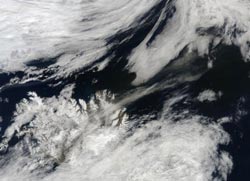NASA's Terra sees ash plume pulled to the northeast by a low

NASA\'s Terra satellite captured the ash plume from Eyjafjallajokull Volcano, Iceland, on May 18 at 12:20 UTC (8:20 a.m. EDT), blowing to the northeast due to a low pressure area. Credit: NASA Goddard / MODIS Rapid Response Team<br>
The brownish ash plume was being pushed to the northeast from a low pressure area situated to Iceland's northeast. The Moderate Resolution Imaging Spectroradiometer or MODIS instrument that flies aboard Terra captured an image on May 18 at 12:20 UTC (8:20 a.m. EDT).
NASA works with other agencies on using satellite observations to aid in the detection and monitoring of aviation hazards caused by volcanic ash. For more on this NASA program, visit: http://science.larc.nasa.gov/asap/research-ash.html.
As weather systems to continue to interact with the ash plume, it will continue to shift, so air travel may always be affected.
Media Contact
All latest news from the category: Earth Sciences
Earth Sciences (also referred to as Geosciences), which deals with basic issues surrounding our planet, plays a vital role in the area of energy and raw materials supply.
Earth Sciences comprises subjects such as geology, geography, geological informatics, paleontology, mineralogy, petrography, crystallography, geophysics, geodesy, glaciology, cartography, photogrammetry, meteorology and seismology, early-warning systems, earthquake research and polar research.
Newest articles

High-energy-density aqueous battery based on halogen multi-electron transfer
Traditional non-aqueous lithium-ion batteries have a high energy density, but their safety is compromised due to the flammable organic electrolytes they utilize. Aqueous batteries use water as the solvent for…

First-ever combined heart pump and pig kidney transplant
…gives new hope to patient with terminal illness. Surgeons at NYU Langone Health performed the first-ever combined mechanical heart pump and gene-edited pig kidney transplant surgery in a 54-year-old woman…

Biophysics: Testing how well biomarkers work
LMU researchers have developed a method to determine how reliably target proteins can be labeled using super-resolution fluorescence microscopy. Modern microscopy techniques make it possible to examine the inner workings…





















